Safety is our first priority
Columbia Generating Station has been operating safely since 1984. Equipped with redundant safety systems, the plant is designed to ensure public and worker safety at all times.
Commercial nuclear power operations involve the safe application of radiological processes. This involves no less than six barriers to ensure radiological products are safely contained. They include:

The plant design also employs a "defense in depth" philosophy that takes into account a multitude of possible accident scenarios. Each plant safety system has built-in redundancy and backup to ensure reliability across a wide range of accident scenarios. Extensive planning, preparation and training are all designed to identify and prepare for equipment malfunctions, earthquakes, power interruptions and more.
A rigorous and ongoing training program is in place to ensure employees are well prepared to handle any situation. Classroom instruction, hands-on practice, and full-scale emergency drills are just a few of the methods used to keep employees and our community safe. Most of our training activities involve city, county and/or state authorities.
Design & Construction
U.S. nuclear plant structures were designed and built to survive massive earthquakes. The Nuclear Regulatory Commission (NRC) requires that the design of U.S. nuclear energy facilities take into account the most severe natural phenomena historically reported or expected for the site and surrounding area. Additional safety margin is then added into a nuclear facility’s design to ensure they withstand much stronger earthquakes than expected. This safety margin not only ensures the survivability of the facility following a natural event that exceeds historical data, but it also ensures the reactor can safely be shut down and cooled using any number of reactor cooling options.
Should an earthquake result in the loss of offsite power, Columbia has three large diesel generators that will continue to power important plant functions, plus two, smaller diesel generators – one mobile and the other static. Columbia also has large installed battery systems which can power equipment directly. All this equipment is regularly tested and stringently maintained.

Fukushima Response
The most important lesson from the Fukushima accident in Japan is that a nuclear power facility must be prepared to handle a catastrophic natural event simultaneously affecting all reactors on the site, regardless of the cause. The nuclear energy industry developed a diverse, flexible approach called FLEX by stationing another layer of backup equipment at each facility site and opening national rapid response centers in Phoenix, Arizona, and Memphis, Tennessee .
The regional response centers are ready to deliver a full set of portable safety equipment, radiation protection equipment, electrical generators, pumps and other emergency response equipment to Columbia within 24 hours. This is equipment beyond the backup generators, portable water pump, construction equipment, hoses, connectors and other back-up safety supplies already at Columbia.